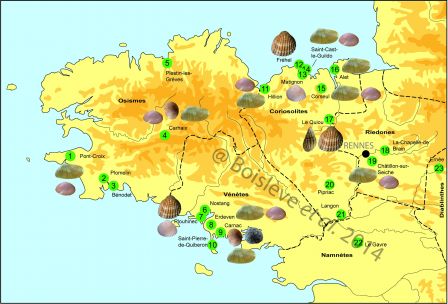Boislève J., Labaune F., Dupont C., 2014 – Les enduits à incrustations de coquillage d’Armorique romaine
Par Catherine Dupont le vendredi 3 avril 2015, 10:04 - Zoom sur publications - Lien permanent
Boislève J., Labaune F., Dupont C., 2014 – Les enduits à incrustations de coquillage d’Armorique romaine, analyse d’un style régional du IIIe s. ap. J.-C (Bretagne, France). In Norbert Zimmemann (dir.) - Antike Malerei zwischen Lokalstil und Zeitstil, Akten des XI. internationalen Kolloquiums der AIPMA (Association internationale pour la peinture murale antique) - 13/17 september 2010 in Ephesos. Österreichische Akademie der Wissenschaften, Philosophisch-Historische Klasse, Denkschriften, 265-275.

Carte de localisation des sites à décor à incrustations de coquillages avec mise en évidence des espèces utilisées
Map of archaeological sites where shells inlays
Résumé
Les fouilles récentes des deux villae de Mané-Véchen en Plouhinec (Morbihan) et du Quiou (Côtes-d’Armor) sises sur le territoire armoricain, ont mis au jour des éléments de décors peints utilisant les coquillages. Point de départ de ces recherches, ces fragments nous ont conduits à reprendre l’intégralité de la documentation et du matériel archéologique disponible pour comprendre la place de cet artisanat dans l’architecture et sa filiation dans les styles décoratifs. La détermination spécifique des coquillages permet aussi de savoir comment la matière première « coquille » s’insère dans cette pratique.
Abstract
We intend here to present a set of decors specific to the western part of the Lyons province, i.e.: coatings with shell inlays. Frequently seen in Italy and on other sites in Gaul, these sets are, however much more numerous in Armorica, presenting specific stylistic and technical traits which indeed constitute a regional group. First they seem to be rid of any materials, so present in opus musivum, other than shells for their inlays, thus doing away with tesserae, Egyptian blue beads, pumice stones and other rocky elements. Only a few decors combine stucco with shell inlays. Otherwise, most coatings use shells to fill up often brightly coloured backgrounds, with black contours. The geometric patterns probably indicate grid-motifs. This technique, it must be noted, is mostly reserved to decorate ceilings to be found most of the time in thermae.
The recent discovery of three decors and the re-examining of former discoveries enabled us to map out those discoveries and to classify the various techniques in use. We shall therefore try here to analyse the technique implemented for these decors and the way they were discovered; we shall also try and see whether they are an adaptation of the nymphea or fountain decorations of 1st century Italy.
The shell analysis comes and completes what we know of the way the various shells were collected, chosen and implemented. It points out to clear choices of certain species and raises the question of their way of supply: trade or the recycling of the discarded shells after sea-shells meals.
Commentaires